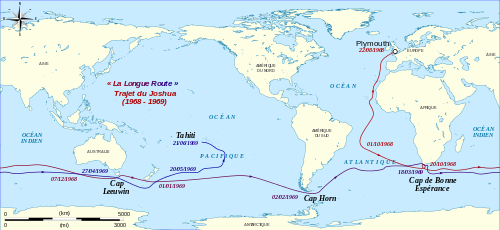Bernard Moitessier
This article has multiple issues. Please help improve it or discuss these issues on the talk page. (Learn how and when to remove these template messages)
|

Bernard Moitessier (April 10, 1925 – June 16, 1994) was a French
Vagabond of the South Seas
Moitessier grew up next to the sea in
With the money from his book, he commissioned a 39-foot steel ketch which he named Joshua, in honour of
Solo around the world

Discussions between Moitessier and his friends
He departed Plymouth on August 23, 1968 and, after a quick passage south, he was off the Cape of Good Hope by October 20, 1968. In the process of transferring a canister of film and reports for the Sunday Times to a freighter, he allowed the bow of Joshua to be drawn into the stern of the ship, bending the bowsprit, which he was able to fix with winches on board.[3] A couple of days later Joshua was knocked flat by a breaking wave but he was able to recover the damage. A succession of gales and calm periods characterised his trip through the Southern Ocean till he passed Cape Horn on 5 Feb 1969. In all this time he got no feedback on the progress of other competitors from local radio stations.
After the period of calms in the Indian Ocean, where Moitessier became depressed and discovered yoga as a means of controlling his moods, he started to think of not returning to Europe, which he saw as a cause of many of his worries. The idea of continuing his voyage on again to the Galapagos Islands strengthened as he passed through the Pacific, though he was still determined to complete the circumnavigation first. Finally, having passed Cape Horn, he had a crisis when a south-easterly gale started blowing him north again, and his account of his thought processes before he turned for the Cape of Good Hope reflects inner turmoil. However, the manner of his resignation, as he tells the story, is a key part of his reputation. By firing a note using a slingshot onto the deck of a passing ship, he was able to get a message to his London Times correspondent, stating: "parce que je suis heureux en mer et peut-être pour sauver mon âme" ("because I am happy at sea and perhaps to save my soul").[4]
The decision to abandon is instructive of Moitessier's character. Although driven and competitive, he passed up a chance at instant fame and a world record, and sailed on for three more months. Sir Robin Knox-Johnston went on both to win the race, as its only legitimate finisher, and to become the first man to circumnavigate the globe alone without stopping.

Although he abandoned the race, Moitessier still circumnavigated the globe, crossing around the
It is impossible to say whether Moitessier would have won if he had completed the race, as he would have been sailing in different weather conditions than Knox-Johnston. Based on the fact that his time, from the start to Cape Horn, was around 77% of that of Knox-Johnston, it would have been an extremely close race. However Moitessier is on record as stating that he would not have won.[1] Moitessier's book of the experience, The Long Way, tells the story of his voyage as a spiritual journey as much as a sailing adventure and is still regarded as a classic of sailing and adventuring literature.
Subsequent life


It took Moitessier two years to finish the book about his trip to Tahiti, during which time he met Ileana Draghici with whom he had a son, Stephan. They moved to the atoll of Ahe, where Moitessier attempted to cultivate fruit and vegetables. Ileana encouraged him to move to America to complete films about his sailing but he left, after two years, in his boat Joshua.
Wreck of the 'Joshua'
In December 1982 Moitessier was offered a yacht charter by film actor
After further travels, Moitessier returned to Paris to write his autobiography, Tamata and the Alliance.
Moitessier was an environmental activist who protested against
Death
Moitessier died of prostate
Partial list of works
- Un Vagabond des mers du sud 1960. Translated by Rene Hague as Sailing to the Reefs. ISBN 9780713659078
- Cap Horn à la voile: 14216 milles sans escale 1967. Translated by Inge Moore as Cape Horn: The Logical Route., Adlard Coles Nautical (30 Jun. 2003), ISBN 9780713667073
- La Longue route; seul entre mers et ciels 1971. Translated as The Long Way by William Rodarmor, 1973, ISBN 978-0924486845
- Tamata et l'alliance 1993. Translated as Tamata and the Alliance by William Rodarmor, 1995, ISBN 978-0924486777
- Voile, Mers Lointaines, Iles et Lagons 1995. Translated as A Sea Vagabond's World by William Rodarmor, 1998, ISBN 9781493042807
References
- ^ a b Eakin, Chris (2009). A Race too Far. Ebury Press. p. 217. ASIN 0091932599.
- ^ Bernard Moitessier, trans. Inge Moore (1969). Cape Horn: The Logical Route. Adlard Coles Nautical.
- ^ a b Peter Nichols (2002). A Voyage For Madmen. Perennial, US.
- ^ Bernard Moitessier, trans. William Rodarmor (1974). The Long Way. Adlard Coles Nautical, UK.
- ISBN 9781574092042.
- ^ "BERNARD MOITESSIER: What Really Happened to Joshua". Wavetrain.net. 5 December 2013.
- ^ "REMEMBERING THE CABO STORM OF 1982". Latitude38.
- ^ "The Death of Bernard Moitessier's Joshua". King Tide Sailing.
- ISBN 9781929214891.
- ^ "Embarquez sur Joshua, le ketch légendaire de Moitessier". Voile Magazine/ Yacht pals sailing website via dailymotion.com. 3 April 2018. Retrieved 7 February 2021.
- ^ "La Rochelle: Joshua's savior visits the Maritime Museum". Francetvinfo.fr (translated from French). 4 September 2017.
